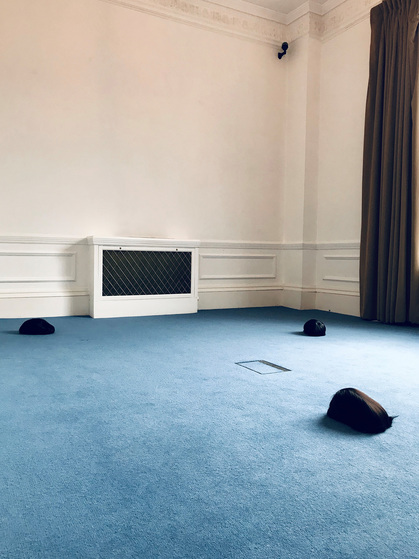-
From Current Issue
-
- Editor’s Letter Fire in the Heart
- Reviews I Gusti Ayu Kadek Murniasih
- Reviews 11th Seoul Mediacity Biennale: “One Escape at a Time”
- Dispatch Networked China
- One on One Monira Al Qadiri on Yukio Mishima
- Essays The rise of independent art spaces in pandemic-era Shanghai
- Features Tuan Andrew Nguyen
- Table of Contents
- Web Exclusives
- Archive
- Subscribe

R
E
V N
E
X
T
Installation view of SHUHEI YAMADA’s The Eyes, 2019, acrylic paint on balloon, 200 × 400 cm, at “Untitled Yet,” Daiwa Anglo-Japanese Foundation, London, 2019. All images copyright and courtesy the artist.
Multimedia artist Shuhei Yamada is best known for stripping images of the recognizable elements that make them easily understandable. The stated aim of this approach is to address our tendency to accept the visual information in front of us too willingly, and force viewers to question what they see. The point such a practice seems to miss is that meaningful criticism is often reliant upon more or less visible symbols, whether they reveal a hidden truth, conceal one, or are so meaningless that their very existence is revelatory. If stripping images of their symbols constitutes the entire critique, the commentary can never advance beyond the imposition of some vague absurdity, and closes the door on any further analysis.
Yamada has recently adopted an ostensibly more socially critical position with his works, although using a similar approach. At their best, his pieces present an intuitive, if not especially generative depiction of contemporary absurdity; at their worst, they use barely anything to say nothing at all. “Untitled Yet,” Yamada’s exhibition at London’s Daiwa Anglo-Japanese Foundation, comprised two works, and represented both eventualities. In the Foundation’s Park Side Gallery, the artist mounted the installation The Eyes (2019). Here, two spherical white balloons sat side-by-side, each two meters in diameter and bearing a black, painted eye. Curiously, the balloon on the left had the depiction of the right eye, while the right orb showed the left eye. Equally as curious, the eyes were of different sizes, and painted complete with eyelids and lashes onto objects that might otherwise serve as eyeballs. This, however, is where any curiosity generated by the work ends. If any meaning or symbol were present, it would have difficulty extending beyond a tired “Big Brother” trope.
In the Mews Side Gallery was an untitled installation, also made in 2019. Three black wigs were placed on the ground, with another blonde one mounted on the wall, and a small semi-circular writing desk in the room’s corner. From the desk and each of the three wigs on the floor, concealed speakers played computer-generated voices reading from texts found on the Instagram profiles of well-known figures, such as Donald Trump, and “organizing consultant” and television personality Marie Kondo. Mining social media as a source and streaming text from Twitter, Facebook or Instagram is not new, but Yamada’s application of the technique was effective. Between the various objects, a cacophony of voices varies in intensity between English and Japanese, with certain phrases occasionally coming to the fore. Most remarkable among these fragments was “faced with tears of joy,” only with “tears” mispronounced by the voice generator to sound like its homograph. The sight of wigs protruding from the ground is absurdly funny, and suggestive of something concealed beneath. Likewise, the fact that the spoken texts were abstracted from Instagram—a network focused on pictures—suggests absence, or at least a way to approach an image’s content that goes beyond the visible. This in turn calls into question the connection between an image, its content, meaning, and the perception of it.
Ultimately, though, Yamada’s claim that his art “create[s] an alternative to this society in order to overcome the simple dualism of good and evil” is questionable.
Ned Carter Miles is ArtAsiaPacific’s London desk editor.
Shuhei Yamada’s “Untitled Yet” is on view at the Daiwa Anglo-Japanese Foundation, London, until April 12, 2019.
To read more of ArtAsiaPacific’s articles, visit our Digital Library.


















